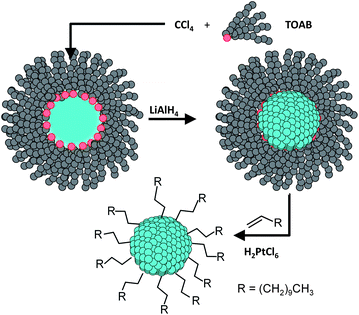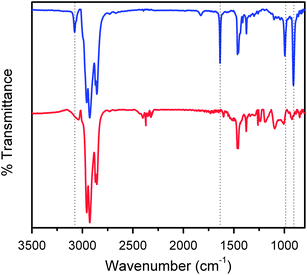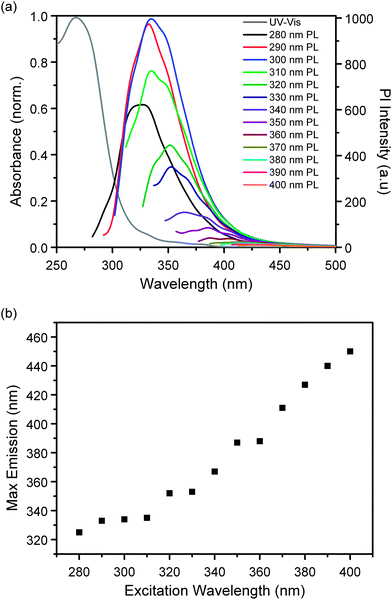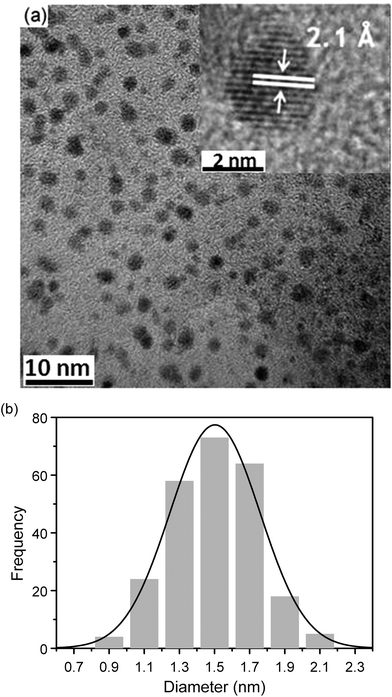Efficient one-pot synthesis of highly monodisperse carbon quantum dots†
Keith
Linehan
and
Hugh
Doyle
*
Tyndall National Institute, University College Cork, Lee Maltings, Cork, Ireland. E-mail: hugh.doyle@tyndall.ie; Tel: +353-21-2346300
First published on 1st November 2013
Abstract
Highly luminescent carbon quantum dots (CQDs) with narrow size distributions were synthesised in reverse micelles using a simple room temperature, solution-phase synthesis. The CQDs are stabilised by covalently bound alkyl ligand to minimise surface oxidation and exhibit blue emission with a marked dependency on excitation wavelength.
The recent emergence of carbon quantum dots (CQDs) as a versatile fluorescence nanomaterial has garnered widespread interest due to their attractive photophysical properties, high quantum yields, low toxicity and biocompatibility.1–3 Compared to conventional organic dyes and semiconductor nanocrystals, CQDs possess several advantages in terms of chemical inertness, easy functionalisation, high resistance to photobleaching, an absence of fluorescence intermittency and the potential for low cost production. As a result, much attention has been paid to their potential application in areas from biological labelling and imaging to fluorescence nanosensors and optoelectronic devices.2,4,5 A number of different synthetic strategies have been developed and reported for the preparation of CQDs, which may be divided into physical and chemical methods. Physical methods include arc discharge,6 laser ablation/passivation7,8 and plasma treatment.9 Chemical methods include electrochemical synthesis,10–12 combustion and acidic oxidation,13,14 hydrothermal and pyrolysis routes,15 supported synthesis16–18 and microwave/ultrasonic synthesis.19,20 However, some drawbacks associated these methods include extensive post-synthetic purification, lack of control of CQD surface chemistry and sample polydispersity. To date, it has been proven difficult to produce ultra-small monodisperse CQDs with narrow size distributions, with many methods still requiring the need for impractical size separation processes to obtain monodisperse CQDs.1
The use of solution based synthetic methods have been the most promising due to their ability to control the size, shape and surface chemistry of the CQDs. Rhee and co-workers reported the solution-phase synthesis of CQDs using reverse micelles as nanoscale reactors.21 The CQDs were formed via condensation polymerisation and subsequent carbonization of glucose within AOT reverse micelles at 160 °C. Control of the water-surfactant ratio within the micelle allowed the CQD diameter to be tuned from 1.8 to 4.1 nm, but with increasing polydispersity at larger diameters. They later reported a similar hydrothermal synthesis of nearly monodisperse (1.4 ± 0.15 nm) CQDs using octanol as the surfactant.22 In both cases, subsequent in situ surface passivation resulted in formation of hexadecylamide-capped CQDs. More recently, Gao et al. reported on the hydrothermal synthesis of CQDs by oxidation of C60 by hydrogen peroxide under alkaline conditions within CTAB reverse micelles at 150 °C.23
In this communication, we report a simple one-pot, solution phase synthesis of highly monodisperse, alkyl-capped, brightly luminescent CQDs formed by chemical reduction of carbon precursors in reverse micelles. This single-phase, room temperature method is inspired by our previously reported syntheses of size monodisperse Group IV nanocrystals.24,25 The overall synthetic procedure is illustrated in Scheme 1. Under inert atmospheric conditions, carbon tetrachloride is dissolved within the hydrophilic interior of a tetraoctyl ammonium bromide (TOAB) reverse micelle; the carbon source material is then readily reduced using lithium aluminium hydride to form hydrogen-terminated CQDs confined within the micelle interior. The surface of the as-synthesised CQDs is then modified using a platinum-catalysed process to form C–C bonds, which chemically passivates the CQD surface to minimise oxidation.
 | ||
| Scheme 1 Schematic of the chemical synthesis and surface passivation of highly monodisperse dodecane-capped CQDs. | ||
Fig. 1(a) shows a transmission electron microscope (TEM) image of the as-synthesized CQDs. The CQDs are highly size and shape monodisperse with no evidence of aggregation, see Fig. 1 and S1 of ESI.† Inset in Fig. 1(a) is a high resolution TEM image showing that the CQDs are highly crystalline with a lattice spacing of 2.1 Å, in excellent agreement with the (100) spacing reported for graphitic carbon. Fig. 1(b) shows a histogram of the CQD diameters, determined by analysis of TEM images of ca. 250 CQDs located at different locations on the grid. The mean diameter of the CQDs is 1.5 ± 0.3 nm, based on fitting the histogram to a Gaussian model.
The surface chemistry of the quantum dots was characterized by infrared spectroscopy; Fig. 2 shows the FTIR spectra of 1-dodecane and the as-synthesised CQDs. Both spectra exhibit strong C–H vibrational modes with symmetric CH2, asymmetric CH2, and the asymmetric C–CH3 stretching vibrations at 2856, 2922, and 2960 cm−1, respectively. Further peaks at 1457 and 1378 cm−1 are attributed to the C–CH2 vibrational scissoring and C–CH3 symmetric bending modes. The presence of the vinyl (R–CH![[double bond, length as m-dash]](https://www.rsc.org/images/entities/char_e001.gif) CH2) group in the spectrum of 1-dodecene is confirmed by the peak at 1640 cm−1, corresponding to the C
CH2) group in the spectrum of 1-dodecene is confirmed by the peak at 1640 cm−1, corresponding to the C![[double bond, length as m-dash]](https://www.rsc.org/images/entities/char_e001.gif) C stretching mode. The peaks at 912 and 992 cm−1 are due to the
C stretching mode. The peaks at 912 and 992 cm−1 are due to the ![[double bond, length as m-dash]](https://www.rsc.org/images/entities/char_e001.gif) CH out-of-plane deformation and CH2 out-of-plane wagging, while the small peak at 3081 cm−1 is due to the
CH out-of-plane deformation and CH2 out-of-plane wagging, while the small peak at 3081 cm−1 is due to the ![[double bond, length as m-dash]](https://www.rsc.org/images/entities/char_e001.gif) CH stretch. The presence of strong CHx peaks in the spectrum of the CQDs, combined with the absence of peaks due to the vinyl group, is consistent with successful binding of the ligand to the quantum dot surface to form dodecane-capped CQDs. The presence of some small peaks between 1300 and 1000 cm−1 is probably due to the presence of oxygenous functional groups such as C
CH stretch. The presence of strong CHx peaks in the spectrum of the CQDs, combined with the absence of peaks due to the vinyl group, is consistent with successful binding of the ligand to the quantum dot surface to form dodecane-capped CQDs. The presence of some small peaks between 1300 and 1000 cm−1 is probably due to the presence of oxygenous functional groups such as C![[double bond, length as m-dash]](https://www.rsc.org/images/entities/char_e001.gif) O and C–O at the surface. However, the relatively low intensity of these peaks indicates that the CQDs are well passivated with minimal oxidation.
O and C–O at the surface. However, the relatively low intensity of these peaks indicates that the CQDs are well passivated with minimal oxidation.
 | ||
Fig. 2 FTIR spectra of 1-dodecene (blue line) and the as-synthesised CQDs (red line). The dotted lines indicate the vinyl (R–CH![[double bond, length as m-dash]](https://www.rsc.org/images/entities/char_e001.gif) CH2) stretching and bending vibrations. CH2) stretching and bending vibrations. | ||
The optical properties of the CQDs were investigated using UV-visible and photoluminescence spectroscopy. Fig. 3(a) shows the absorbance and photoluminescence spectra of the dodecane-capped CQDs in hexane. The absorption spectrum shows a peak centred at 264 nm with an onset of absorbance at 370 nm. This is in excellent agreement with reports of graphitic carbon CQDs strongly absorbing in the UV region. The photoluminescence spectra were obtained using excitation wavelengths ranging from 280 to 400 nm in 10 nm increments. The wavelength position of the PL maximum ranges from 325 nm for excitation at 280 nm to 450 nm for 400 nm excitation. This corresponds to an overall red shift in the PL peak position of 125 nm, as the excitation wavelength is increased by 120 nm; see Fig. 3(b). This clear dependency on excitation wavelength has also been widely observed for CQDs prepared using different methods of preparation and surface functionalities.1–3
 | ||
| Fig. 3 (a) UV-vis absorbance and photoluminescence spectra of CQDs dispersed in hexane. (b) Wavelength position of the luminescence maximum as a function of excitation wavelength. | ||
To date, the origin of luminescence for CQDs remains controversial and complicated due to the wide variety of methods reported, together with the different ligand schemes, surface oxidation and broad particle size distributions which all contribute to the lack of consensus.1–3 The wavelength dependency has been mainly attributed to optical selection of differently sized nanocrystals (i.e. a quantum confinement effect), and/or emissive trap states on the surface but the exact mechanism still remains unresolved.1,3 Given the high degree of size monodispersity in the CQDs reported here, the most plausible explanation is that the blue luminescence originates from recombination of excitons at shallow surface trap states.7,24 The high degree of surface passivation may also contribute to the narrow PL spectra (FWHM: 60 nm) observed. The CQDs also exhibit excellent long-term PL stability, decreasing by less than 4% after continuous illumination for 12 hours; see Fig. S2.†
In conclusion, we have developed a simple room temperature route that readily provides alkyl-capped CQDs, with close control of internal structure and surface chemistry. The use of micelle templates thus allows for superior control over the CQD size, which is highlighted by the narrow size distributions achieved. The CQDs are readily dispersed in hexane, tetrahydrofuran, chloroform, toluene and other non-polar solvents, making them amenable to low cost, solution based device processing. The one-pot synthetic method reported here provides an attractive approach for efficient production of highly monodisperse CQDs with facile control of surface chemistry and passivation without the need for any size separation steps.
This work was supported by the European Commission under the FP7 Projects SNAPSUN (grant agreement no. 246310) and CommonSense (grant agreement no. 2618309) and the Irish Higher Education Authority under the PRTLI program (Cycle 3 “Nanoscience” and Cycle 4 “INSPIRE”).
Notes and references
- H. Li, Z. Kang, Y. Liu and S.-T. Lee, J. Mater. Chem., 2012, 22, 24230–24253 RSC.
- J. C. G. Esteves da Silva and H. M. R. Gonçalves, TrAC, Trends Anal. Chem., 2011, 30, 1327–1336 CrossRef CAS PubMed.
- S. N. Baker and G. A. Baker, Angew. Chem., Int. Ed., 2010, 49, 6726–6744 CrossRef CAS PubMed.
- W. Kwon, S. Do, D. C. Won and S.-W. Rhee, ACS Appl. Mater. Interfaces, 2013, 5, 822–827 CAS.
- F. Wang, Y.-H. Chen, C.-H. Liu and D.-H. Ma, Chem. Commun., 2011, 47, 3502–3504 RSC.
- X. Xu, R. Ray, Y. Gu, H. J. Ploehn, L. Gearheart, K. Raker and W. A. Scrivens, J. Am. Chem. Soc., 2004, 126, 12736–12737 CrossRef CAS PubMed.
- Y. P. Sun, B. Zhou, Y. Lin, W. Wang, K. A. S. Fernando, P. Pathak, M. J. Meziani, B. A. Harruff, X. Wang, H. Wang, P. G. Luo, H. Yang, M. E. Kose, B. Chen, L. M. Veca and S. Y. Xie, J. Am. Chem. Soc., 2006, 128, 7756–7757 CrossRef CAS PubMed.
- H. Goncalves and J. C. G. Esteves da Silva, J. Fluoresc., 2010, 20, 1023–1028 CrossRef PubMed.
- H. Jiang, F. Chen, M. G. Lagally and F. S. Denes, Langmuir, 2009, 26, 1991–1995 CrossRef PubMed.
- Q. L. Zhao, Z. L. Zhang, B. H. Huang, J. Peng, M. Zhang and D. W. Pang, Chem. Commun., 2008, 5116–5118 RSC.
- L. Zheng, Y. Chi, Y. Dong, J. Lin and B. Wang, J. Am. Chem. Soc., 2009, 131, 4564–4565 CrossRef CAS PubMed.
- J. Zhou, C. Booker, R. Li, X. Zhou, T. K. Sham, X. Sun and Z. Ding, J. Am. Chem. Soc., 2007, 129, 744–745 CrossRef CAS PubMed.
- H. Liu, T. Ye and C. Mao, Angew. Chem., Int. Ed., 2007, 119, 6593–6595 CrossRef.
- X. Wang, L. Cao, F. Lu, M. J. Meziani, H. Li, G. Qi, B. Zhou, B. A. Harruff, F. Kermarrec and Y. P. Sun, Chem. Commun., 2009, 3774–3776 RSC.
- D. Pan, J. Zhang, Z. Li, C. Wu, X. Yan and M. Wu, Chem. Commun., 2010, 46, 3681–3683 RSC.
- R. Liu, D. Wu, S. Liu, K. Koynov, W. Knoll and Q. Li, Angew. Chem., Int. Ed., 2009, 121, 4668–4671 CrossRef.
- J. Zong, Y. Zhu, X. Yang, J. Shen and C. Li, Chem. Commun., 2011, 47, 764–766 RSC.
- A. B. Bourlinos, A. Stassinopoulos, D. Anglos, R. Zboril, V. Georgakilas and E. P. Giannelis, Chem. Mater., 2008, 20, 4539–4541 CrossRef CAS.
- H. Zhu, X. Wang, Y. Li, Z. Wang, F. Yang and X. Yang, Chem. Commun., 2009, 5118–5120 RSC.
- X. Wang, K. Qu, B. Xu, J. Ren and X. Qu, J. Mater. Chem., 2011, 21, 2445–2450 RSC.
- W. Kwon and S. W. Rhee, Chem. Commun., 2012, 48, 5256–5258 RSC.
- W. Kwon, S. Do and S.-W. Rhee, RSC Adv., 2012, 2, 11223–11226 RSC.
- M. X. Gao, C. F. Liu, Z. L. Wu, Q. L. Zeng, X. X. Yang, W. B. Wu, Y. F. Li and C. Z. Huang, Chem. Commun., 2013, 49, 8015–8017 RSC.
- K. Linehan and H. Doyle, Small, 2013 DOI:10.1002/smll.201301189.
- K. Linehan and H. Doyle, MRS Online Proc. Libr., 2013, 1546 CAS , mrss13-1546-l06-1548.
Footnote |
| † Electronic supplementary information (ESI) available: Synthetic method, characterisation and additional figures. See DOI: 10.1039/c3ra45083j |
| This journal is © The Royal Society of Chemistry 2014 |

